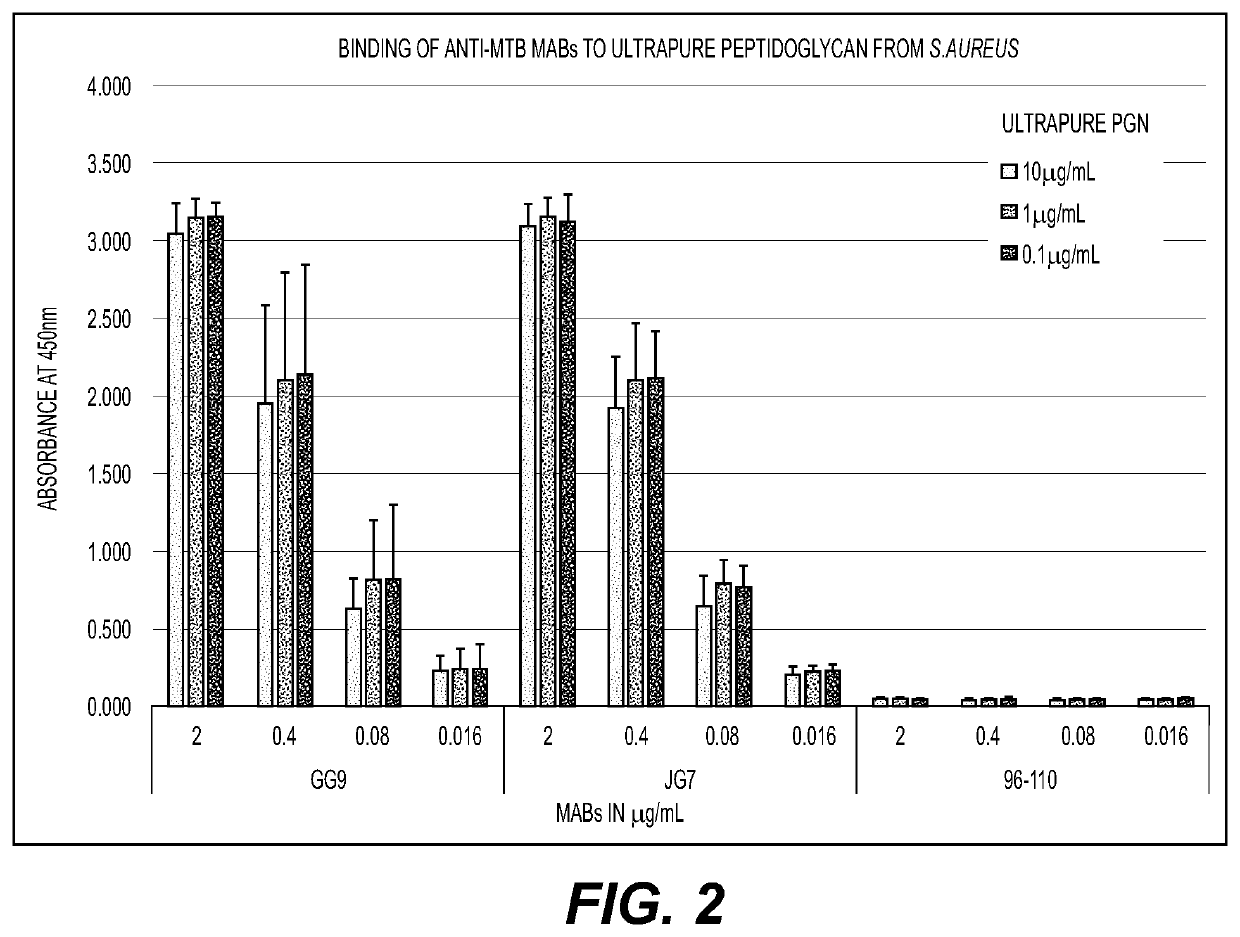Immunogenic Antigens
a technology of immunogenic antigens and antigens, which is applied in the field of immunogenic antigens, can solve the problems of inability to effectively make conventional vaccines, inability to retain typical bacteriological stains, and inability to proliferate tuberculosis /i>, and achieve the effect of preventing or reducing inflammation
- Summary
- Abstract
- Description
- Claims
- Application Information
AI Technical Summary
Benefits of technology
Problems solved by technology
Method used
Image
Examples
example 1
[0093]Two monoclonal antibodies (MABs) generated from mice immunized with ethanol-killed Mycobacterium tuberculosis (MTB) (anti-MTB MABs GG9 and JG7) and one anti-LTA MAB (96-110) were screened by Enzyme-Linked Immunosorbent Assay (ELISA) to determine recognition of cell wall antigens. Binding of MABs GG9, JG7 and 96-110 to a cell wall mixture and ultrapure PGN, both derived from Staphylococcus aureus was analyzed. MAB (96-110) directed against LTA only bound to the impure cell wall mixture that contained both LTA and PGN (FIG. 1) and not to the ultrapure PGN (that does not contain other cell wall components such as LTA) (FIG. 2), while anti-MTB MABs JG7 and GG9 bound to both the cell wall mixture and ultrapure PGN. Thus, antibodies specific for PGN and LTA can avidly bind each of the cell wall components (FIGS. 1 and 2).
example 2
[0094]Female ICR mice were immunized subcutaneously with Ultrapure PGN, unconjugated or CRM-conjugated using three doses: 5, 20 and 50 μg / mouse and given with TiterMax Gold adjuvant (unconjugated PGN was only given at 50 μg). Booster immunizations were given on Days 20, 42 & 64 and retino-orbital bleeds were performed on Days 28, 42, 63 and 81. Antisera binding to PGN, MTB and various gram-positive bacteria were analyzed by ELISA. Unconjugated PGN was immunogenic in mice, but there was generally a more robust response in the conjugated groups compared to the unconjugated responses (FIG. 3). Strong immune responses to the cell wall component PGN and to several strains of MTB were detected and highest titers were evident from MS 190, 191, 196 & 197 (FIGS. 4 and 5). Thus, mice immunized with PGN alone or PGN-CRM conjugate vaccines develop a robust humoral response that demonstrated strong binding to PGN and bound to Mycobacteria to include MTB and M. smegmatis as well as other gram-pos...
example 3
[0095]Immunization with PGN or LTA vaccines makes provision for the induction of humoral immunity and production of hybridomas that secrete anti-PGN and anti-LTA antibodies. Such antibodies, raised against cell wall components, can promote OPKA of bacteria and enhance clearance from the blood. Notably, from a group of ICR mice immunized with CRM-conjugated PGN (20 μg), mouse 190 elicited a strong immune response to PGN, MTB and other gram positive bacteria and led to its splenocytes being harvested and fused with myeloma cell line SP2 / 0 for the development of hybridoma MD11. Several anti-PGN positive clones (MD11) bound strongly to PGN (FIG. 6). These clones also showed strong binding to Mycobacteria, S. aureus and B. subtilis (FIG. 7). Supernatant collected from five hybridoma MD11 clones in 96 & 24-well culture plates bound to Ultrapure PGN, MTB, SMEG and other gram-positive bacteria (FIG. 5).
PUM
| Property | Measurement | Unit |
|---|---|---|
| time | aaaaa | aaaaa |
| time | aaaaa | aaaaa |
| time | aaaaa | aaaaa |
Abstract
Description
Claims
Application Information
 Login to View More
Login to View More - R&D
- Intellectual Property
- Life Sciences
- Materials
- Tech Scout
- Unparalleled Data Quality
- Higher Quality Content
- 60% Fewer Hallucinations
Browse by: Latest US Patents, China's latest patents, Technical Efficacy Thesaurus, Application Domain, Technology Topic, Popular Technical Reports.
© 2025 PatSnap. All rights reserved.Legal|Privacy policy|Modern Slavery Act Transparency Statement|Sitemap|About US| Contact US: help@patsnap.com



